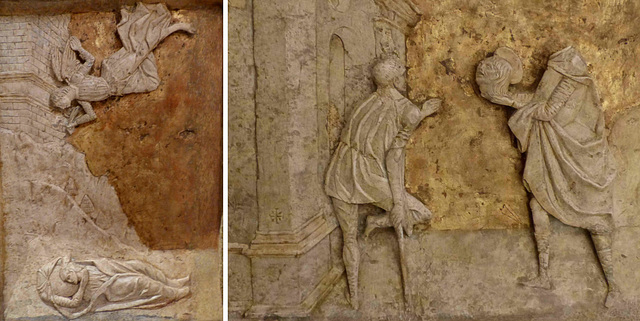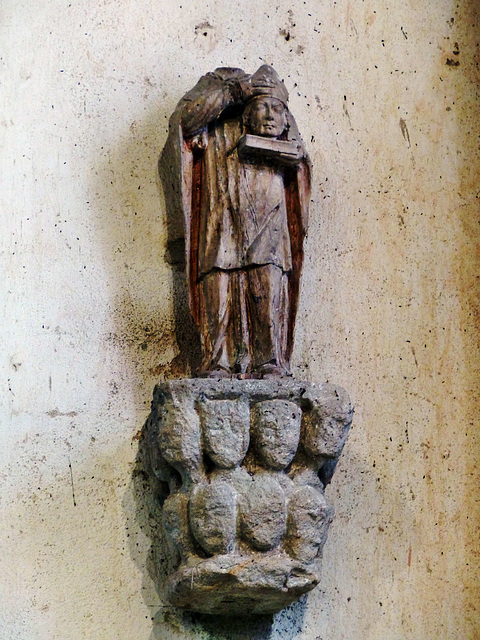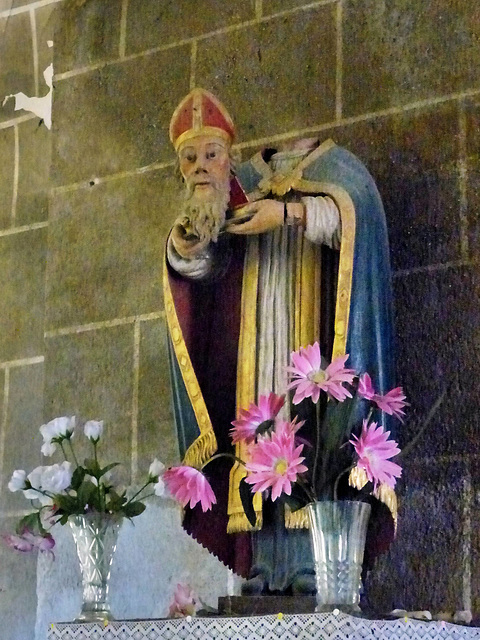
Cephalophores
Cephalophores (= head-carrier) are martyrs who are depicted carrying their own severed heads. The most famous cephalophore is Denis, patron saint of Paris, who, according to the Golden Legend, miraculously preached with his head in his hands while journeying the seven miles from Montmartre to his burying place but there are many more.
Fidenza - Cattedrale di San Donnino
In 1927, which is quite recent, the town "Borgo San Donnino" changed its name to "Fidenza" as it was known as "Fidentia Julia" in Roman times.
The city was given its name and the Duomo within the walls was dedicated to San Donnino di Fidenza (aka 'Donninus of Fidenza'), who was martyred nearby in 291. A legend tells, that when Charlemagne passed through "Borgo San Donnino", an angel told him, where to dig for San Donnino´s relics. He is connected to the city and the duomo.
Sigeric the Serious, Archbishop of Canterbury, made a pilgrimage to Rome on the Via Francigena around 990. His contemporary accounts of this voyage still exist (and are the source of modern guidebooks). He reached "Sce Domnine" after 36 days, which is pretty fast for 1000+ km.
Frederick Barbarossa had entrusted "Borgo San Donnino" to the Pallavicino family from Piacenza. In 1268, after a siege, the city was conquered by the troops of Parma, who plundered and burned it completely. All houses were destroyed at that time, only the unfinished Duomo was saved.
The erection of the Cattedrale di San Donnino had started in the 11th century, the first consecration took place in 1106, though the building process continued. From around 1200 on Master Benedetto Antelami and his workshop worked here, not only as Master masons. Antelami may as well be the architect of the facade.
The martyrdom of Saint Donnino is depicted above the doors.
Fidenza - Cattedrale di San Donnino
In 1927, which is quite recent, the town "Borgo San Donnino" changed its name to "Fidenza" as it was known as "Fidentia Julia" in Roman times.
The city was given its name and the Duomo within the walls was dedicated to San Donnino di Fidenza (aka 'Donninus of Fidenza'), who was martyred nearby in 291. A legend tells, that when Charlemagne passed through "Borgo San Donnino", an angel told him, where to dig for San Donnino´s relics. He is connected to the city and the duomo.
Sigeric the Serious, Archbishop of Canterbury, made a pilgrimage to Rome on the Via Francigena around 990. His contemporary accounts of this voyage still exist (and are the source of modern guidebooks). He reached "Sce Domnine" after 36 days, which is pretty fast for 1000+ km.
Frederick Barbarossa had entrusted "Borgo San Donnino" to the Pallavicino family from Piacenza. In 1268, after a siege, the city was conquered by the troops of Parma, who plundered and burned it completely. All houses were destroyed at that time, only the unfinished Duomo was saved.
The erection of the Cattedrale di San Donnino had started in the 11th century, the first consecration took place in 1106, though the building process continued. From around 1200 on Master Benedetto Antelami and his workshop worked here, not only as Master masons. Antelami may as well be the architect of the facade.
There are reliefs in the church telling the story of Saint Doninnos, a cephalopore bearing his severed head. Left he is called by an angel during a nap, right is healing a cripple.
Soulosse-sous-Saint-Élophe - Saint-Élophe
Soulosse-sous-Saint-Élophe (pop. ~650) was formed out of four hamlets. The two larger ones were Soulosse und Saint-Élophe.
The church, dedicated to Saint-Élophe was built in the 13th and 15th centuries and so there is a mix of Romanesque and Gothic styles.
Legends tell, that Saint Élophe (aka "Eliphius of Rampillon") preached the bible in the area and was martyred and beheaded on the spot.
After his death in 363, he got up and went with his head in his hands to his burial site - the place, where the church is now. So he became a member of the large group of "kephalophores", who all carried away their own head after the death. Other members of the group are Saint Denis, Saint Sever, Saint Gohard, Saint Miniato.
The tomb effigy of St. Elophe. Carved at the end of the 16th century.
There is a small mysterium here. During the summer solstice (21.06) it can be observed. that the sun passing through a stained glass window projects colours that move all along the statue until the neck is lit red and the face a pale green.
Soulosse-sous-Saint-Élophe - Saint-Élophe
Soulosse-sous-Saint-Élophe (pop. ~650) was formed out of four hamlets. The two larger ones were Soulosse und Saint-Élophe.
The church, dedicated to Saint-Élophe was built in the 13th and 15th centuries and so there is a mix of Romanesque and Gothic styles.
Legends tell, that Saint Élophe (aka "Eliphius of Rampillon") preached the bible in the area and was martyred and beheaded on the spot.
After his death in 363, he got up and went with his head in his hands to his burial site - the place, where the church is now. So he became a member of the large group of "kephalophores", who all carried away their own head after the death. Other members of the group are Saint Denis, Saint Sever, Saint Gohard, Saint Miniato.
The tomb effigy of St. Elophe. Carved at the end of the 16th century.
Le Châtelet - Notre-Dame-de-Puyferrand
Puyferrand (= Puy-Ferrand) is a small hamlet, that is part of the small town Le Châtelet. The church was part of a priory, sponsored by the Seigneurs de Déols, existed here since 1070. As the church as well served the growing parish, the church got enlarged already within the 12th century by an additional nave, named "Chapelle Saint-Blaise".
The church was built following the blueprint of a "Latin Cross" with a long nave crossed by a transept.
The church got severely damaged in 1569 during the Wars of Religion. The structure was rebuilt later. Many of the carvings outside got destroyed during the wars, only a few survived (previous uploads).
The capitals around the crossing are older and clearly differ in style. They are very rough - and enigmatic. This capital got reused as a base for statue. The top row of heads may depict horned devils (?), while below are the heads of poor sinners. Over all these heads is a beheaded saint.
There are many "kephalophoroi", martyrs who carried their heads away after they were beheaded. The best known in France is Saint Denis.
Deux-Chaises - Saint-Denis
The village was dependent on the the mighty and important "Abbaye royale de Saint-Denis" near Paris. No wonder the 12th century church was dedicated to Saint Denis. Saint Denis was bishop in Paris within the 3rd century. He was martyred and is mostly seen holding his head in his hands (= "kephalophor"), just like here. When I was a kid I was stupefied with horror, when I saw statues like this..
Durham - Cathedral
Durham has its origins in 995, when monks from Lindisfarne, at that time on the run from the Vikings for over 100 years, chose this place as the final resting place for the mortal remains of St Cuthbert of Lindisfarne and founded a church.
Cuthbert's grave attracted many pilgrims and over time a town developed around the church. In 1006 and 1038, this settlement was unsuccessfully attacked by Scots. The hilltop location of the town proved to be easy to defend.
There was a predecessor building, a former Lindisfarn priory, from Anglo-Saxon times. The foundation stone of the cathedral was laid under the first bishop, William of St Calais, in 1093. With the monastery connected to it and its position on a difficult-to-attack hill in a bend of the River Wear, the complex served as Northumbria's bulwark against the Scots. The present building was substantially completed between 1093 and 1133. It is a significant example of the Romanesque style, and the nave ceiling is the earliest surviving example of a pointed rib vault. The east end was expanded in the Early English Gothic style in the 1230s
The early Gothic west towers were completed in 1220. The west façade was given a large front window.
The Romanesque choir end was demolished and replaced by the Chapel of the Nine Altars in 1242-1280.
During the Reformation in England, initiated by Henry VIII, many of the furnishings were destroyed in the first iconoclasm. In 1539, the king also dissolved the Benedictine monastery in Durham. Around 1560, the medieval wall paintings that covered all the church walls inside were whitewashed and the figuratively designed stained glass windows were destroyed.
Cephalophores, saints who carry their own head, are often found in France (e.g. St Denis).
This could be St Cuthbert, but most often he is actually seen with two heads, his own and that of St Oswald, who was buried here with him. It is possible that the iconoclasts destroyed the head of St Cuthbert.
Jump to top
RSS feed- Latest items - Subscribe to the latest items added to this album
- ipernity © 2007-2024
- Help & Contact
|
Club news
|
About ipernity
|
History |
ipernity Club & Prices |
Guide of good conduct
Donate | Group guidelines | Privacy policy | Terms of use | Statutes | In memoria -
Facebook
Twitter








